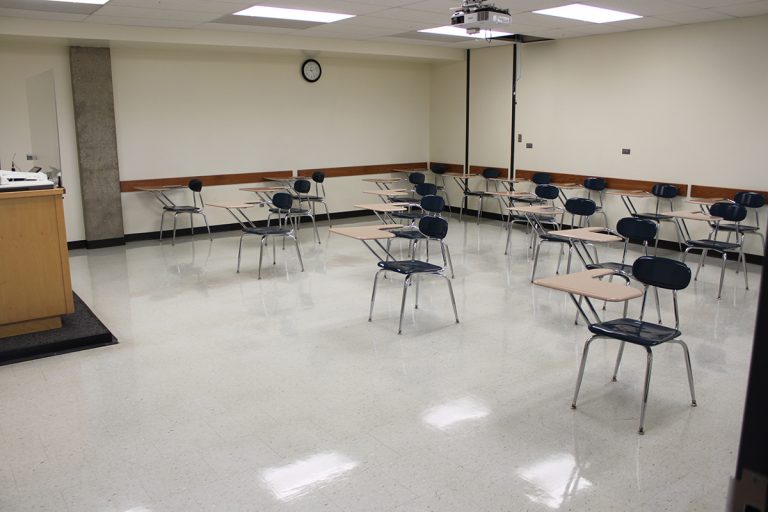HyFlex Training: Part 2


Sharing Content via HyFlex at NDSU
When you walk into a classroom at NDSU, it will be very much like what you’re used to. The classroom will be an “instrumented classroom,” which means that it’s set up with the technology you need to conduct your class. You should be able to walk into your classroom, log into the computer, touch the touch panel to wake the technology, and the system will start. The main difference is that you will have to start the video conferencing software you plan to use, whether that’s Class Collaborate Ultra, Zoom, or Teams.
Remote students will see and hear content you share through your video conference connection. And, of course, your in-class students will see the content because it will be projected.
One difference is that there will be, or there should be, a Smart Podium in all of the classrooms. We say “should” because, as you know, the equipment arrival is out of our control. (Update: Smart Screens have now been installed in all classrooms.) But, the Smart Podium will be an enhanced feature for you as teachers. For example, if you bring up a PowerPoint, or you want to annotate or draw on something and save it, you can. That’s going to be a nice addition for instructors to have in their toolbox.
This semester, there is the added ability for the document camera in the rooms to be shared. The document camera is also an input you will be able to share with your distance students. Learn more about the HyFlex classroom technology.
Teaching from home

None of us knows what the future holds, so it’s best to be prepared. If you should have to teach from home at some point during the semester, there are a few things you will want to have in place. First, you will need a TA, GA, or someone in your class to start the equipment and software in that physical classroom. Your appointed person will enter the classroom, go to the teaching podium, log into the computer, start the touch panel, and log into whatever software you’re using (Zoom, BB Collaborate, or Teams). They should also select the classroom camera. That way, as faculty teaching remotely, you will see the entire classroom. Once this has been set up, the NDSU classroom and the remote students will see and hear content you share through the video conference connection.
“netiquette” is the word used for etiquette via technology, and it’s essential to your classroom environment.

Sharing content – Best practices
We will now share some of the best practices we’ve collected for both in-class and remote student learning. If you haven’t heard, “netiquette” is the word used for etiquette via technology, and it’s essential to your classroom environment. Learn more about netiquette in the faculty resources section of our website.
The first best practice is simple, remind your in-class students that their voices and side conversations can be heard and may even be recorded. Now that we have microphones in the classrooms, there is added ambient noise students need to be aware of. You can remind your class that you recognize this is a different behavior for them because typically, students walk into the classroom chatting. Still, they may need to limit their chatting or loudness because this could affect the quality of the audio.
For your remote students, remind them that connecting to a Zoom session is the equivalent of walking into your classroom. It’s a good idea to remind students that the same principles apply to them as to the on-campus students, so they should behave professionally on their cameras. Remind students that they need to treat others with courtesy and respect in the chats and in what they’re saying. They also should be reminded to be in a somewhat appropriate setting and wearing proper attire during class.

A second topic that should be discussed with your class is how you would like them to handle questions remotely. Do you want them to raise their hand? Is it a small enough class where they can simply unmute their mic and ask the question? Make sure that you’re very clear in your syllabus about these rules. You may want to tell them that they need a headset, preferably one with a microphone; This will cut down on some of the technical issues.
Ask your remote students to use a proper name on their profile. It can be what they prefer to be called, but it should not be a nick-name or something unrecognizable, it needs to be their name so that you know who they are and can quickly call on them.
Have a plan for monitoring the chat during class. There’s no getting around that adding monitoring the chat to your teaching routine is one added responsibility for you. Monitoring the chat is going to be especially difficult if you have a large class. We recommend that you have a TA or even a student who watches the chat during your lecture or class time. That way, the TA or student can chime in when it’s appropriate, and you can address the question; this not only helps you to coordinate your lecture, but it keeps those students engaged as well. As you know, this will be different depending on whether you’re teaching remotely or in-class. Still, everyone should feel like they’re in class together. It’s your responsibility as an instructor to make sure that questions are addressed and taken care of, if not during class, possibly at the end of class or later.
Additional Tip: Make sure you copy the chat at the end of your class session so that if there were any leftover or unanswered questions, you can address them. You could make an announcement at the end of class, such as, “I will post any unanswered questions today in our forum or on Blackboard.”

Create opportunities for engagement and discussion. A chat proctor is going to be a way to keep people engaged. Another way is to ask remote students to chat their answers while asking the in-person class questions out-loud. You will hear the responses coming in and then read some answers from the remote student’s chat aloud to your classroom. Additionally, you might ask a remote student to unmute their microphone and give a response to the class. This way, you are not just teaching to the students in front of you; you are including everyone.
Encourage your remote students to use their video cameras. We understand that bandwidth can be an issue, but if students can use the video, please tell them to do so. You also need to be understanding if that’s not possible for a student due to bandwidth or computer limitations. Consider implementing a quick “check-in” at the beginning of class where you see their faces while taking attendance. Of course, that is up to each instructor to decide. We do suggest instructors use their cameras at all times. You are the center of that learning arena, and you should be visible to the class.

Make a purposeful attempt to recognize your remote students. Remote students are probably feeling a bit disconnected from the group, naturally. If your before class ritual is to walk into the room and greet your students, do the same for your remote students. You might even call some students out by name, “I’m glad to see you here today, David.” That way, your remote students feel included before class even begins.
Encourage student feedback frequently. Have students tell you if something isn’t working for them. You can be honest and say, “You know, this is a new teaching modality for all of us. If something isn’t working for you, let me know right away.” You should also ask your remote students if they hear you and the class clearly. Let students know that you want to fix whatever issues there are right away so that nothing interferes with their learning experience.
Other Important Considerations
Decide whether or not you are going to allow private chat during your sessions. In some cases, such as smaller class size, or a graduate-level course, you may want to leave private chat on so that students can help each other if they do not understand a concept. That is entirely up to each instructor, but it should be considered and established early.

Be mindful of time. It’s very easy to lose track of time when you’re teaching remotely. Although you may be teaching from home, you still have to stick within those class periods. It’s an important consideration to make for students as well, as classroom locations have changed, and some may have a different walk to their next class than before the classroom reassignments.
Consider creating a discussion board for questions, especially if you have a large class. This could allow students the opportunity to answer each other’s questions, which promotes participation and engagement. It will also offer insight to what concepts they might not be grasping and areas that you should revisit in future lectures.
Additional Tip: If you wanted to take it one step further, you could create a frequently asked questions form where commonly asked questions are addressed. For example, “Should my camera be on or off?” or, “Should I be handing in or posting my homework to blackboard?”. Questions that, for a large class, could be repeatedly asked and take time to answer individually.
Group work – Integrating On-campus and Remote Students
How will group work look for your course? Good question! Think about your classroom space. Does it allow room for you to separate students into groups while maintaining social distancing? If yes, great! You have nothing else to worry about. If no, you want to consider using Zoom or Class Collaborate Ultra to create breakout sessions.
Another thing you will want to consider is whether your group work needs to happen during class time or out of class. If your group work is taking place during class time, you may want to ask your students to bring laptops or devices that they can use for these group sessions. Remember, the future is unknown, and just because a student is in class one day does not mean that they will be attending the next class. Therefore, groups working on projects should not be determined by location. For group projects, remote and in-class students should be combined.

We strongly encourage you to mix your on-campus students with remote students and not to keep them separate. The central concept of HyFlex is the option to be present or not. For whatever reason students may choose to be at home, you should be prepared for the class size to fluctuate.
Whichever way you choose to run your groups, think about this ahead of time and plan. Make sure that your students understand that group work is a responsibility and that if someone all of a sudden can’t make it in, the others have to come up with a plan so that they can all work together.
Additional Tip: Google Docs is an excellent way for your groups to communicate and work together on projects. It saves work in real-time, and everyone can see the changes taking place. We recommend you encourage your groups to use platforms like Google Docs for their collaboration and group work.

Best practices for group work:
- We cannot stress enough the importance of having clear expectations in the syllabus.
- Polling questions are a great way to engage your students, both remotely and in-class. You can use polling questions on Class Collaborate Ultra and in Zoom.
- Have one place where all of your content is located. For instance, keeping everything (announcements, syllabus, assignments, etc.) on Blackboard Learn Original. This way, your students will not have to be asking you where things are, they will understand that all content is in the same location.
Hopefully, this post has helped you to conceptualize how your HyFlex classroom environment will work and flow. For more resources, visit the IT Knowledge Base Training and Workshops page. Additionally, our HyFlex Training: Part 3 will examine how to utilize assessment in the HyFlex model.
About the Authors:

Tammy Cummings holds a Master of Science in educational leadership and administration from NDSU and a B.S.W. degree in social work from Minnesota State University, Moorhead. She is an instructional services specialist, with NDSU’s Instructional Technology division. She assists in planning and implementing training for instructors related to teaching methods and/or the use of Blackboard and other supported NDUS technologies. Her focus area is on Bb collaborate and Clicker technology. Tammy is a two-time nominee of the Gunkleman Award and the recipient of the ND Counseling Association’s Friend of Counseling Award.

Holly DeVries is a Graduate Assistant in the Office of Teaching and Learning and is in the second year of pursuing her M.Ed. in Clinical Mental Health Counseling at NDSU. She holds a Bachelor of Music degree from Minnesota State University Moorhead and has worked in the music industry on both East and West Coasts before returning to the Midwest. Holly is passionate about diversity and inclusion and is specifically interested in LGBTQ+ advocacy.